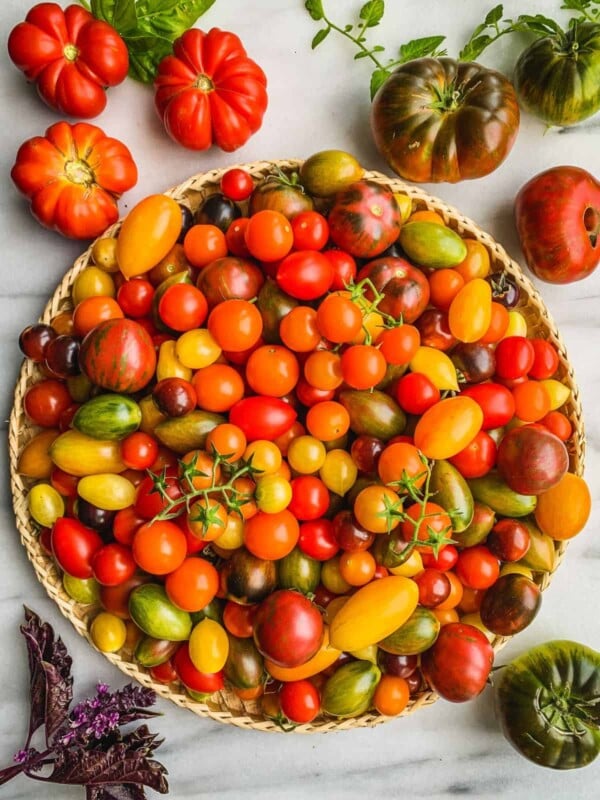One of the world’s most important culinary herbs, parsley (Petroselinum crispum) is a species of flowering plant in the Apiaceae or Umbelliferae family of aromatic flowering plants that include hundreds of species including carrots and celery.
This post will cover everything you need to know such as the different varieties, culinary uses, how to grow, how to store and preserve, substitutions and recipes.

Table of Contents
History
Parsley is native to the central and eastern Mediterranean region but has been naturalized elsewhere in Europe. It is widely cultivated as an herb (for its leaves), and a vegetable (root parsley).
Culinary Uses
Parsley is commonly used in European and Middle Eastern cuisine. There are 3 main varieties of parsley.
Curly parsley is oftentimes used as a garnish (in my opinion, an outdated practice). The most famous use for curly parsley remains Tabbouleh, a Middle Eastern salad that consists of finely chopped curly parsley, chopped tomatoes, and bulgur wheat.
Flat leaf parsley, also known as Italian parsley, is much more versatile and can be used as a garnish, in marinades, and in sauces such as authentic chimichurri and chimichurri with pomegranate molasses. It can be added to salads, Sicilian Pesto and more.
Parsley root (also referred to as root parsley) is a common root vegetable used in central and eastern European cuisine. It can be added to soups and casseroles or enjoyed raw like carrots and other root vegetables.

Other uses
Parsley seed oil is used in the manufacturing of soaps, perfumes, and cosmetics. The seeds, roots, and leaves are used by some for medicinal applications.
High-Level Nutritional Information
Parsley is a source of luteolin, apigenin, folate, vitamin K, vitamin C, Vitamin A, lycopene, alpha-carotene and beta-carotene. As always, for specific nutritional information or for dietary advice, please consult a licensed dietician or nutritional specialist.
How to Grow Parsley
Parsley is a biennial, meaning that its lifecycle occurs over 2 years in temperate climates. In the first year, parsley grows bushy and lush, providing you with an ample supply of tender delicious green leaves that can grow up to 12” (30cm) long with clusters of 0.5”-1” (1-3cm) leaflets.
As winter approaches, parsley goes dormant. The following spring, the parsley plants will produce a flower stem topped with an umbel (an inflorescence that consists of a number of short flower stalks called pedicels that spread from a common point – similar to an umbrella frame). After the flowers mature and set seeds, the plants will die back.
I personally grow parsley as an annual. Growing it as an annual means that you’ll have an abundance of green leaves to use in the kitchen. If you are a seed saver, then you can certainly treat parsley as a biennial and allow it to go to seed.
Parsley grows well in the ground, in raised beds, and in containers. It is also well suited for hydroponic growing. You can start it from seed (it does need 6-8 weeks of indoor or greenhouse growing before it can be transplanted outdoors), or purchase seedlings in the spring from a local nursery or garden center.

Parsley needs full sun to thrive, but will do well in part shade as well. It will not grow as bushy or as vibrant in full shade.
If you’re interested in learning more about growing culinary herbs, vegetables and flowers, please visit my gardening education platform, gardenologie, where you can get free gardening tips or enroll in a Master Class.
Favorite Varieties to Grow
Flat-leaf parsley is the way to go for general needs. It is the most versatile. Giant of Italy by Johnny’s Seeds is a great variety to start from seed. However, there’s no shortage of parsley seedlings at garden centers and nurseries come spring.
If your family loves Lebanese tabbouleh like mine does, then growing a curly variety will also be worthwhile. Darki or Wega from Johnny’s seeds are excellent varieties.
How to Harvest
Parsley should be harvested by cutting what is needed from the plant without damaging the central growing point. The easiest way to harvest would be to work from the outside of the plant inward. Harvest only what you need. If you plan to preserve a large quantity of parsley and want the plant to continue growing, harvest up to 50% of the plant only.
Culinary Substitutions
Parsley is easy to grow and find at most if not all grocery stores. There are several substitutions possible:
- Cilantro can be used as a substitute however it is important to note that the flavor profile will be altered, especially if using large quantities. It is best to use cilantro as a substitute only as a garnish. Cilantro can be used in marinades as a substitute as well.
- Celery leaves. The innermost-tender leaves of celery can be used, especially in salads and as a garnish.
- Chervil is closely related to parsley and can certainly be used. It is more difficult to find in a market or grocery store, however, is it as easy to grow as parsley so consider adding it to your herb garden.
- Basil is a great substitute, especially in marinades, soups, salads and even sauces.
How to store
Fresh parsley should be stored in the refrigerator. There are a few ways to do this:
- Bundle parsley stems and leaves, wrap in a wet paper towel and store them in a plastic bag in the refrigerator. Parsley may stay fresh for up to 7 days this way.
- Treat parsley like you would fresh flowers. Place stems upright in a mason jar with water. Parsley placed in water this way can last for a few hours on the counter. For longer-term storage, place the jar in the refrigerator with a thin plastic bag loosely covering the parsley. Change the water every few days. Parsley may stay fresh for up to 14 days this way.
Parsley purchased from the grocery store can remain in the produce bag, stored in the refrigerator crisper. I personally prefer to wash freshly purchased parsley, spin it dry, and store it in a container or clean bag. I can then use it as is without having to wash it again.

How to Preserve
Preserve parsley for long-term storage in several ways.
- Drying: This isn’t my preferred method, as I am not a fan of dried parsley. However, if you like dried parsley, you can certainly dehydrate it.
- Compound butter: Freezing fresh chopped parsley in butter is a wonderful way to preserve it. Use pats of compound butter on grilled vegetables, steaks, and more.
- Freeze: Freezing parsley leaves and stems is a great way to extend their usefulness. Stems can be added to broths and frozen leaves can be chopped and added to soups and stews.
Check out this parsley preservation blog post for more information.
Recipes
There are several recipes on my blog that feature parsley, such as Linguine with Sicilian Pesto, Short Rib Ragu, Mushroom Pappardelle and of course, most importantly, Hand Chopped Chimichurri Sauce. It is also featured in my Cilantro Chimichurri, Mint Chimichurri and Red Chimichurri!
Main Dishes
Main Dishes
Levantine Recipes
Condiments
If you have any questions, please take a moment to leave a comment below. It’s such a help to others who want to try the recipe. For more Urban Farm and Kitchen, follow along on Instagram, Facebook, and Pinterest, visit the Urban Farm Shop, or subscribe for new posts via email.















